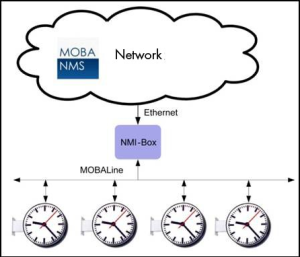
In our January 2012 newsletter we highlighted the state-of-the-art in time distribution technology. Currently, new installations of time systems and clocks are network-based and rely on LAN- cabling. NTP (network time protocol) is the reliable time standard for the synchronisation of clocks as well as for the time reference of IT-sub-systems.
Nevertheless, there are few draw-backs to the time over Ethernet concept. First, a LAN-based installation may result in higher costs due to necessary Ethernet cabling, switches and injectors. Secondly, LAN-cabling is limited to 100m, without adding additional switches, and cabling topology of the LAN needs to be star-shaped and connections between clocks are not possible. Finally, existing buildings are often not equipped with an Ethernet, and retrofitting with a LAN is too expensive.
The drawbacks of the time over Ethernet concept have created a demand for other time distribution technologies. A vast part of this demand is time codes for self-setting clocks. These time codes benefit from the use of a simple two-wire cable, which is cheaper than LAN-cabling and is often already available in the existing building.
Mobatime Swiss time systems have set the industrial standard for time codes for self-setting clocks with MOBALine. The main advantages of MOBALine compared to other time codes in the market are free cabling topology (parallel, serial, star), time and date information, no extra powering of slave clocks, low power consumption (6mA per slave clock), world time function on one line, switching functions on the same MOBALine, and alarm detection.
In reality, a decision for a time distribution system is not always ‘take it or leave it’ for one specific technology. There are good reasons why a mix of different technologies can make sense:
- Expansion: a building with an existing time distribution system can be expanded.
- Upgrade: certain components of the time system can be up-graded without eliminating still usable devices (e.g. master clocks).
- Cost-savings: an Ethernet cabling is foreseen as the major network in a building, but the detailed dispersion canbe done with a more economical cabling.
- Flexibility: the detailed installation place of the slave clocks are not yet defined during design phase, which should allow a certain flexibility to place the slave clocks in the final installation.
Mobatime develops its products and provides solutions which allow the fusion of different technologies and respond to the above mentioned challenges of practical installations.
Master clocks: DTS 4801/4802
Besides the NTP-output, the DTS master clocks offer one (DTS 4801) or two (DTS 4802) lines, either in MOBALine or impulse mode. This structure allows the management of two or even three different time codes with one master clock at the same time: NTP, MOBA-Line and impulse. They provide the MOBALine functionality on the old two-wire network and, in parallel, the distribution of NTP for IP-based clocks on the LAN. The multi-output concepts of DTS master clocks also ensure a cost-efficient, step-by-step transformation of a MOBALine/ impulse time system into an NTP-system, and therefore guarantee good investment protection.
Movements: SAN/SEN 40 – SAM/SEM 40 and NBU 190 – MLU 190
The Mobatime movements for small (30cm-40cm) and medium (50cm-80cm) size clocks for different time codes (NTP or MOBA- Line) are of the same shape and make use of the same hand fixation. This uniformity is of great advantage when it comes to the retrofitting of existing clocks. In case a building gets a new LAN-network instead of the two-wire cabling,the existing slave clocks – running on Mobaline – can be retrofitted with new NTP-movements. This uniformity helps to save costs and to preserve particular clocks, particularly old or customised clock designs.
NMI: Network-MOBALine- Interface
The NMI is the latest product for the fusion of NTP and Mobaline technology. Its interfacing characteristics help to combine NTP and Mobaline installation and to benefit from the advantages of both technologies. The NMI contains the following features:
- Synchronisation of the NMI over the Ethernet by means of NTP.
- Provides a Mobaline output for up to twelve self-setting slave clocks.
- The supervision of the NMI is done with the MOBA-NMS.
- The enhanced function of the Mobaline output allows the supervision of the connected slave clocks by MOBA-NMS.
- The slave clocks are powered through Mobaline connected to the NMI.
The NMI increases the flexibility and reduces the costs of a time system. By installing one NMI, for example on an office or hospital floor, the costs for twelve Ethernet connectors and several dozen meters of Ethernet cabling can be saved.
Furthermore, the exact location of a clock can be defined when interior installations (e.g. furniture, pictures) have been decided, and the wiring can be done easily by the simple two-wire cable. Ethernet networks are often installed in the floor, but these clocks are suspended two or more meters above. The remaining distance can be overcome with the MOBALine cabling.
The NMI increases the functionality of Mobaline slave clocks.
Limitation in supervision is eliminated; Mobaline slave clocks plugged to an NMI will show their proper operation in the MOBA-NMS (network management system), and ensure the entire visibility of the time system from a remote location.
Mobatime Swiss time systems is in the front line when it comes to state-of-the-art technology for time distribution systems. The proof is our distributed time system (DTS) for IP-based time systems, which sets the industrial standard. For 75 years we have ensured the availability, development and combination of different technologies such as NTP and Mobaline. Our customers benefit from our unparalleled functionality, increased flexibility, cost-efficient installations and a great deal of investment protection.
